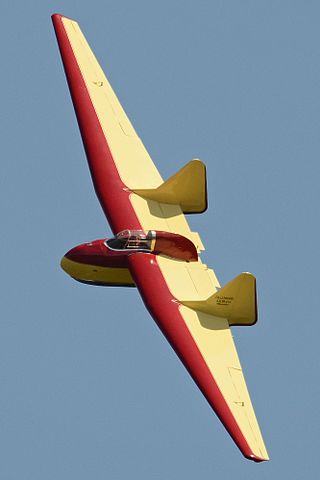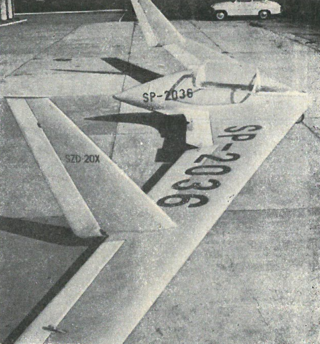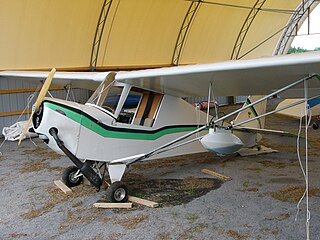
The Aer-Pegaso M-100 was a single-seat glider designed and built in Italy from 1957.

The Fauvel AV.36 was a single-seat tailless glider designed in France in the 1950s by Charles Fauvel. Although the "AV" in AV.36 stands for Aile Volante, it was not a true flying wing: it featured two large fins mounted on stubby tailbooms extending back from the wing's trailing edge, and accommodated the pilot within a stubby fuselage. The aircraft was designed to be quickly disassembled for road transport, with the nose detaching, and the fins able to fold back against the trailing edge of the wing. A refined version with a slightly longer wingspan, the AV.361 was introduced in 1960.

The Bradley BA 100 Aerobat is an American aerobatic homebuilt aircraft that was designed and produced by Bradley Aerospace of Chico, California. When it was available the aircraft was supplied as a kit for amateur construction.
The Fauvel AV.45 was an unorthodox motor glider produced in France in the 1960s and 1970s. Like other Charles Fauvel designs, it was a tailless aircraft, in this case inspired by the work that German firms had done on producing motorised versions of his AV.36 design. The prototype of the AV.45 was an extensively modified AV.36 powered by a Nelson H-59 two-stroke engine. AV.45s have been built with a number of other engines, however, including at least one aircraft powered by a small turbojet. Falconar marketed the plans in the 1970s.

The Hoffmann H40 was a prototype sport aircraft built in Germany in 1988. Designed by Wolf Hoffmann based on his Dimona motor-glider, it was a conventional, low-wing monoplane with side-by-side seating for two and tricycle undercarriage. The aircraft's high aspect ratio wings and T-tail were carried over from its motorglider heritage, but the span was shorter than that of the Dimona. Construction throughout was of composite materials. Hoffmann intended this aircraft to compete with sporting two-seaters such as the Grob G 115 and Robin ATL, but was unable to find the financial backing to bring the aircraft to market, despite a 30% share bought in the project by German pump manufacturer ABS.

The SZD-20x Wampir II was a single-seat tail-less research glider designed and built in Poland from 1959.

The Scheibe Bergfalke is a German glider designed by Egon Scheibe as a post-World War II development of the Akaflieg München Mü13 produced before and during the war.

The IS-5 Kaczka was a single-seat canard research glider designed and built in Poland from 1948.
The Fisher FP-606 Sky Baby is a Canadian single-seat, conventional landing gear or tricycle landing gear-equipped, single-engined, high-wing monoplane kit aircraft designed for construction by amateur builders. Fisher Flying Products was originally based in Edgeley, North Dakota, United States, but the company is now located in Woodbridge, Ontario, Canada.
The Fisher Horizon is a family of Canadian two-seats-in-tandem, conventional landing gear, single-engined, high-wing monoplane kit aircraft designed for construction by amateur builders. The Horizon 1 was inspired by the Aeronca Champion and its later version, the Bellanca Citabria, while the Horizon 2 was inspired by the Cessna O-1 Bird Dog.

The Fisher FP-101 is an American single-seat, high-wing, conventional landing gear, tractor configuration single engine ultralight aircraft that was available in kit form from Lite Flite of South Webster, Ohio and later Fisher Flying Products of Edgeley, North Dakota.

The Whisper Aircraft Whisper motor glider is a South African two-seat kit aircraft that was designed by Russell Phillips in 2004 and is produced by Whisper Aircraft of Port Elizabeth. Major assemblies are completed at the factory with assembly intended to be completed by the owner. It is powered by a four-cylinder Limbach L2000 aero engine with options for the 85 hp (63 kW) Jabiru 2200 and 80 hp (60 kW) Rotax 912 available.

The Scheibe SF 34 Delphin is a two-seat sailplane that was produced by Scheibe in Germany in the late 1970s and 1980s. Designed by Wolf Hoffmann and originally designated the SF H34, it was Scheibe's first unpowered aircraft of composite construction.
The Civil Aviation Department RG-1 Rohini is an Indian two-seat training sailplane of the 1960s. A high-winged wooden monoplane, with side-by-side seating;at least 107 were built.

The Diamond HK36 Super Dimona is an extensive family of Austrian low-wing, T-tailed, two-seat motor gliders that were designed by Wolf Hoffmann and currently produced by Diamond Aircraft Industries.
The Striplin Lone Ranger is a family of American ultralight aircraft that was designed by Ken Striplin. The aircraft was supplied as a kit for amateur construction.
The Lambert Mission 212 is a conventionally laid out low-wing, fixed undercarriage, single-engine, four-seat kit built aircraft designed in the UK by a Belgian college student. Kits are manufactured in Belgium.
The Civil Aviation Department MG-1 was a one-off Indian motor glider, seating two side by side and first flown in 1983.
The Duane's Hangar Ultrababy is an American homebuilt aircraft that was designed by Duane Patrick and produced by Duane's Hangar of Liberty, South Carolina, introduced about 1997. When it was available the aircraft was supplied in the form of plans for amateur construction.
The Vancil Spitz S1 is an American homebuilt aircraft that was designed and produced by A. Vancil of Belton, South Carolina, introduced in the late 1990s. When it was available the aircraft was supplied as a kit and also in the form of plans for amateur construction.











